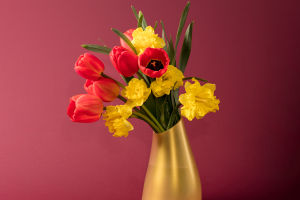Tulips and daffodils are two of the most beloved spring flowers, each bringing vibrant color and charm to gardens worldwide.
These iconic blooms often find themselves planted together, but the question remains: should they be paired or kept apart?
Let's explore the unique characteristics, growing requirements, and aesthetic potential of both flowers.
A Tale of Two Blooms
Tulips, originating from Central Asia, have captivated gardeners with their wide range of colors and elegant cup-shaped blooms. They come in nearly every shade imaginable, from bright reds and yellows to soft pastels and even multi-colored varieties. Tulips are typically taller, with stems reaching up to 24 inches, making them a striking centerpiece in any garden.
Daffodils, on the other hand, are native to Europe and North Africa and are easily recognized by their trumpet-shaped blooms. These flowers predominantly come in shades of yellow, though some varieties exhibit white, orange, or pink hues. Daffodils are slightly shorter than tulips, with most varieties growing between 6 to 20 inches in height. Their bright, cheerful appearance has earned them the nickname "the harbingers of spring."
Growing Requirements: Harmony or Conflict?
One of the first considerations when deciding whether to plant tulips and daffodils together or apart is their growing requirements. Both flowers are spring bloomers, but they have some differences in their needs.
- Soil and Sunlight: Both tulips and daffodils thrive in well-drained soil with plenty of organic matter. They also require full sun to partial shade to bloom at their best. In this regard, they are well-matched and can grow together without much conflict.
- Watering: Both flowers prefer moist but not waterlogged soil, particularly during their growing season in the fall and spring. Overwatering can lead to bulb rot, a common issue for both tulips and daffodils. If planted together, ensure the soil is well-draining and be mindful not to overwater.
- Planting Depth: Tulips generally need to be planted deeper than daffodils. Tulip bulbs should be planted about 6-8 inches deep, while daffodils prefer a depth of 4-6 inches. If you decide to plant them together, you may need to adjust the planting depth for optimal growth, which could require a bit of strategic planning.
Bloom Timing: A Symphony or a Solo?
Another factor to consider is the timing of their blooms. Both tulips and daffodils are early spring bloomers, but their peak bloom times can differ depending on the variety and local climate.
- Daffodils: These flowers are usually the first to bloom, often appearing as early as late February in mild climates and continuing through April. Their early bloom makes them a wonderful way to signal the arrival of spring.
- Tulips: Tulips tend to bloom slightly later than daffodils, typically from March to May, depending on the variety and location. This staggered bloom time can create a continuous display of color if the two are planted together.
When planted together, daffodils can serve as the opening act, with tulips taking center stage as the season progresses. This sequence can create a dynamic and ever-changing garden, with one flower seamlessly transitioning into the next.
Aesthetic Considerations: Complementary or Clashing?
From an aesthetic standpoint, the combination of tulips and daffodils can be breathtaking. The contrast of tulips' sleek, smooth petals with the ruffled, trumpet-shaped daffodils creates visual interest and texture in a garden. The wide range of colors available in tulips can be paired with the cheerful yellows and whites of daffodils to create a striking display.
- Color Pairing: When planting these flowers together, consider complementary or contrasting color schemes. For a harmonious look, pair yellow tulips with yellow or white daffodils. If you prefer a bold, contrasting display, mix deep red or purple tulips with bright yellow daffodils.
- Spacing: Proper spacing is crucial when planting tulips and daffodils together. Overcrowding can lead to competition for nutrients and reduced flowering. Ensure that each bulb has enough space to grow and that taller tulips do not overshadow shorter daffodils.
Companion Planting: Benefits and Drawbacks
Planting tulips and daffodils together offers several benefits. Their similar growing requirements make them compatible companions in the garden. Daffodils are also known to be deer and rodent-resistant, offering some protection to tulips, which are more susceptible to these garden pests.
However, there are some potential drawbacks. Tulips tend to be more short-lived, often requiring replanting every few years, while daffodils are perennials that return year after year. This difference in longevity may require additional maintenance if you choose to plant them together.
Whether you choose to plant tulips and daffodils together or apart depends on your personal preferences and gardening goals. Together, they can create a stunning, continuous display of color and texture that lasts throughout the spring. If you prefer a more uniform garden or have specific design plans, planting them apart may be the better option.
Either way, both tulips and daffodils bring the beauty and joy of spring to any garden, ensuring a vibrant and lively start to the season.


